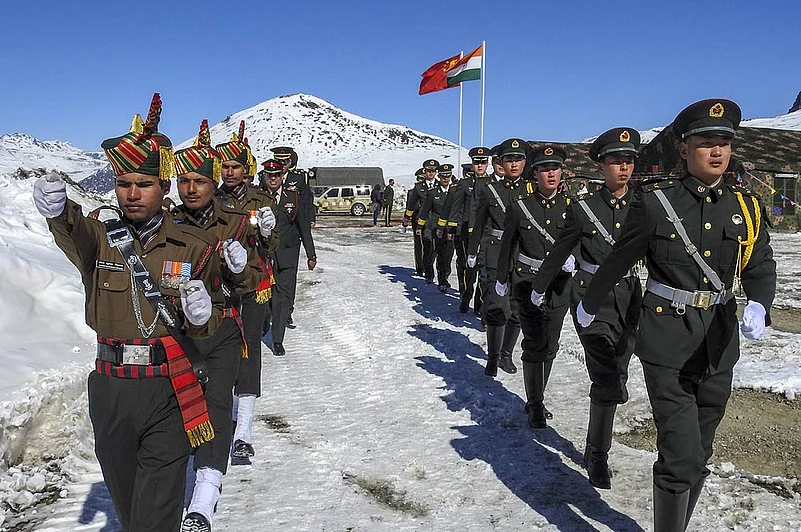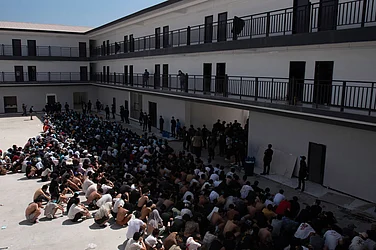All indications point to the fact that ties between Asian rivals, India and China, are unlikely to improve in the next five years, as a rising China tries to stamp its dominant status in Asia and the world.
Relations went into a deep freeze following the military confrontation between the two armies in the summer of 2020, resulting in a clash in the Galwan valley that led to the loss of lives on both sides. As many as 20 Indians and three or more Chinese soldiers were killed. Since then, despite several rounds of military and diplomatic talks, the situation has remained tense.
The fact that a short clip of the PLA (People's Liberation Army) regiment commander Qi Fabio, confronting Indian soldiers in Galwan, ahead of the clash, was part of the Chinese military showcasing its achievements, at the Great Wall of the People, where the Communist Party of China held its once in five-year gathering, tells its own tale. Qi Fabio was also a delegate at the 20th Chinese People’s Congress which concluded on Sunday. Three PLA generals from the Western Theatre Command, bordering India, were promoted to the Central Military Commission. This is of some concern to those watching developments from New Delhi.
"India-China ties are likely to be much more challenging in the next five years. With President Xi Jinping consolidating his position despite a slowing down of the economy and the covid lockdowns, he will feel that his policies in the last five years have the approval of the people. There will be no inclination to change track, so tension and confrontation with India will continue. As US-China rivalry intensifies, India will also be seen as one of the US allies, so less inclined to break the ice,’’ said former foreign secretary Kanwal Sibal.
He also regarded the showing of the Galway clip as China’s assertion of not just its nationalism but also claims to Ladakh. Sibal believes as Russia’s dependence on China accentuates in the next few years, China will be happy to drive a spoke in India-Russia ties.
India will have to prepare for a more aggressive China on its border. Since the summer of 2020, New Delhi has begun the process but it will take a lot of catching-up to compete militarily with its powerful neighbour. Modernizing the fighting forces, building border infrastructure and stitching up alliances with multiple, especially the US, EU, Japan, Australia and other western powers that regard China as a threat are already in place. Joining the quad-the US, India, Japan, Australia group- was prompted by China’s frequent incursions across the Line of Actual Control which is a provisional border between the two countries. Quad is an alliance to contain China’s unprecedented push for dominance across Asia.
"India's search for a more balanced and stable relationship with China takes it across multiple domains and many options. Given the developments of 2020, they obviously focus on an effective defence of the border. This was notably undertaken even in the midst of Covid," foreign minister, Subramanyam Jaishankar said at a recent lecture on India-China relations. He said in the past India had taken a bilateral approach to China, emanating from India’s belief in Asian solidarity (under Nehru and talk of the Asian century during Manmohan Singh’s tenure) and suspicion of third-party interests.
"Indeed, Indian policy in the past has exhibited a remarkable degree of self-restraint that led to the expectation that others can have a veto over its choices. That period, however, is now behind us. The 'new era' is apparently not just for China," he explained.
Luckily for India, its suspicion of Chinese motives is now being echoed by the US and other western powers. The US which got together with China in 1971 to thwart the Soviet Union, now realises that Russia is no longer a long-term threat. The US challenge for the future is China as the Biden administration's recent unveiling of America’s latest National Security Strategy notes.
The US-China rivalry is likely to intensify in the next decade and all countries will have to brace themselves for the consequences of this power play, much as they did during the Cold War era. For India, the choice had already been made.
A confident Beijing under President Xi Jinping is aiming to one day make China the world’s foremost power. The quad, will work together across the Indo-Pacific and counter the spread of China’s influence across the Indo-Pacific, which includes the Indian Ocean. But the US and its allies are also looking at de-coupling the world economy from China. Establishing alternative supply chains is part of the strategy. In the decades following Richard Nixon’s overtures to China, the US and western dependence on each other has grown exponentially thanks to the fantastic returns that resulted in decades of high growth through close economic cooperation between China and the world. Though the process of de-coupling will take time and will cause pain to US companies as well, the process has begun. The US recently barred American companies from exporting chips and advanced chip equipment to China to cripple its semiconductor industry. Semiconductors are also vital in the development of artificial intelligence, in which China currently has an edge over America. These restrictions are one of the most important shifts in US tech exports to China.
The US, India, and Japan are also pushing an alternative more transparent development model to compete with China’s Belt and Road Initiative, which has placed many of the recipients in a debt trap.
The quad is not a military alliance unlike AUKUS, the latest Australia, UK and US military alliance to ensure free movement across the South China Sea and the larger Indo-Pacific. As disputes over the South China Sea continue between China and several East Asian countries, the US pivot to Asia is to establish the freedom of navigation as well as protect American interests in the larger Indo-Pacific region. China had been aggressively patrolling the waters here and claiming the entire South China Sea as its own.
If the 19th Party Congress was a coming-out party for China under Xi Jinping’s leadership, the 20th takes this forward. Before the 19th Congress, China’s aim was development. Deng Xiaoping’s advice to his people was to put their heads down and get to work. But by the time Xi came to take on the mantle, China was ready to take on the world and assert its economic and political clout. As Michael Pillsbury wrote in his book, The Hundred Years Marathon, this had always been the aim of China’s leaders from the very beginning of the rapprochement with President Nixon. But the Chinese had kept their ambitions secret, until now. Having become the number two economy of the world, with a well-equipped and sophisticated modern army and enough funds to launch an ambitious belt and road initiative to spread Chinese influence around the world, President Xi Jinping is ready to take on the task of making China the foremost world power.
But China first needs to establish its dominance over Asia. This is why New Delhi has to be well-prepared for a more aggressive China in the next few years. As Neelam Deo, a former Indian diplomat puts it, "In the next few years, India-China ties are unlikely to ease. The situation does not look good and New Delhi must prepare for all eventualities.’’ As the Chinese economy slows down thanks to the global downturn as well as the disruptions caused by Xi’s strict zero tolerance to covid continues, China could face some "hard moments" said Neelam Deo, adding, "A brittle state could become adventurous."



























